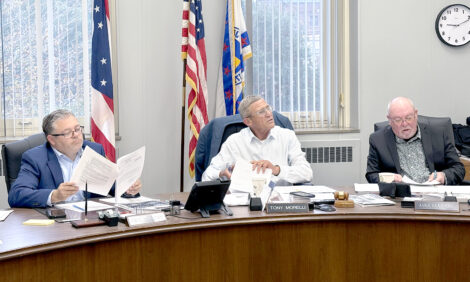Medical student debt: A look at where WVU stands and what it means
MORGANTOWN — Out of 160 medical schools across the country, WVU’s ranks 86th for the amount of average student debt among graduates, according to data from the Association of American Medical Colleges published in Becker’s Hospital Review.
WVU medical school’s average debt load for students graduating in 2024 was $188,892. Marshall University’s medical school ranked 113, with an average $161,652, according to the AAMC.
Both schools fare better than the national average of $212,341.
The West Virginia School of Osteopathic Medicine confers D.O degrees rather than M.D. degrees and was not included in the list.
The Dominion Post talked to Clay Marsh, chancellor and executive dean of WVU Health Sciences, about what the numbers mean. We’ll take a closer look at the figures and then get marsh’s perspective on them.
According to AAMC, Tulane University School of Medicine in New Orleans had the highest average debt load, at $317,890. University of Houston Tilman J. Fertitta Family College of Medicine in Texas had the lowest load, at $33,993. Seven schools had an average $0 debt load, for various reasons.
Nationally, 71% of medical students carry some debt, with 56% carrying more than $200,000 worth. At WVU, 89% carry debt. For Marshall, it’s 96%.
Medical school costs can exceed doctoral training costs for other professions, and Marsh said there are several reasons for that. One is supply and demand. Last year, WVU had 6,500 applications for 115 slots.
WVU, he said, prioritizes West Virginia resident students first, then non-residents with close West Virginia affiliations, and then out-of-state students with no state affiliations. Last year, 145 West Virginia students applied.
“We’re proud of that,” he said. They want to have all qualified West Virginia students accepted into WVU or Marshall or the osteopathic school, and stay here and serve the state.
Another factor contributing to costs is the instructors, he said. Many of them are physicians or healthcare workers who are well compensated.
“We don’t want to see our students have any more debt than is necessary,” he said. Based on national figures, WVU’s tuition is right on target for out-of-state students and a little below average for in-state students.
“But it’s still very expensive and I do think that that’s an important opportunity for us for the future, is to figure out how to make medical school or other professional schools more affordable.”
Does medical student debt contribute to high healthcare costs? Marsh said U.S. spending on healthcare last year was $4.6 trillion – more than $14,000 per person, which is twiceas much as the average Western country, but we still have lower health outcomes.
There are many factors contributing to those costs and the role of student debt isn’t clear, he said. But debt can play a role in which area of practices students choose. Lower-paying specialties may make it harder to pay off debt – approximating a house mortgage without the house – and could lead them to decide not to serve in rural areas or not to go into lower-paying specialties.
Becker’s published an article on Doximity’s Physician Compensation Report 2025 which includes a ranking of specialties by pay. Neurosurgery is at the top, at $749,140 per year.
Pediatric endocrinology is at the bottom, at $230,426. But general pediatrics, family medicine and internal medicine are also in the bottom 20 – at $265,230, $318,959 and $326,116, respectively.
The Becker’s story raised a new issue that will play a role in student debt: the One Big Beautiful Bill recently passed by Congress. It includes federal loan caps of $200,000 staring in July 2026, and ends the federal Grad PLUS loan program, which allows students to borrow up to the full cost of attendance, including living expenses.
Becker’s speculates that this could lead some considering a medical career to choose another field, and contribute to the physician shortage.
We asked Marsh if he thought the OBBB will play such a role, and he said, “I think it’s going to play a huge role.” Students will face a challenge without other sources of money, such as scholarships, parent contributions or schools offering tuition and fee reductions.
Rural areas are a significant issue in healthcare, he said, and combining these loan measures with OBBB’s changes to Medicaid, rural areas will face more challenges and pressures.
“That really is going to require us all to be creative and try to understand what may be additional measures to try to help students and others who want to enter the field of patient care.”
We asked if WVU is considering some measures. He named a few.
WVU has a MATTER track – the Mountaineer Accelerated Track to Enter Residency. Qualifying students who want to complete their specialty training residency in the state have the opportunity to finish medical school in three years instead of four.
In MATTER’s first year, he said, five participated. Last year, more than 20 applied. With the accelerated medical school program, students can save money and reduce their debt load.
WVU and Marshall both have an accelerated track where a student applying for an undergraduate degree can also apply for medical school at the same time. They can complete their bachelor’s in three years, and with MATTER could finish medical school in three years – a total of six instead of eight – thus reducing their debt. This is an option for a small number of the more extraordinary students.
Another possibility is a student agreeing to some years of service in West Virginia in in exchange for tuition forgiveness or having some portion of the loans paid off.
Marsh noted that students who do their residency training here are more likely to stay here – about 77% – compared to those who train for their specialty out of state and return, just 7%.
“We, like others, have actively worked to try to reduce student debt,” he said.
The conversation ended on a positive note. The most recent federal jobs report, he said, shows healthcare jobs staying in equilibrium. This means healthcare is an area of tremendous growth for jobs and economic development.
“We see our role as being able to create pipelines for our health system and other health systems in the state so we can meet the needs of our citizens with the highest skilled professionals,” he said. It’s WVU’s responsibility to continue to perform at higher and higher levels, including finding ways to reduce student debt.



